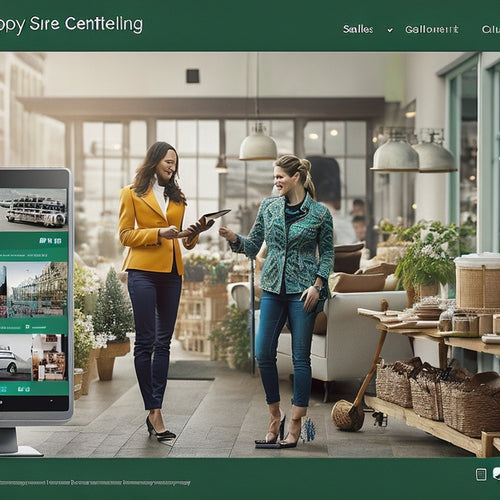
Boost Customer Loyalty With Online Merchant Courses
Share
By launching an online merchant course, you're not only opening doors to new revenue streams but also stepping into a complex landscape where customer satisfaction and loyalty are make-or-break factors. To boost customer loyalty, you need to identify and address pain points, analyze customer feedback using tools like Medallia and Qualtrics, and develop effective communication strategies. Building trust through transparency, personalizing customer experiences, and creating loyalty programs can also drive customer satisfaction. By adapting to customer needs and measuring retention rates, you can exceed customer expectations. Now, take the next step to discover how to turn your customers into loyal advocates.
Key Takeaways
• Identify and address pain points to create a seamless customer experience, leading to increased loyalty and satisfaction.
• Utilize customer feedback analysis tools to gain insights and optimize the customer experience, driving loyalty and retention.
• Develop effective communication strategies, including personalization and timely response, to build trust and strong customer relationships.
• Foster trust and transparency by being open and honest about business practices, policies, and procedures, increasing customer loyalty.
• Offer personalized experiences tailored to customer needs, driving loyalty and retention through targeted promotions and initiatives.
Identifying Pain Points Matters
When launching an online merchant course, you frequently encounter pain points that can make or break your business, and identifying these issues is crucial to developing a successful strategy. You need to pinpoint areas that hinder customer satisfaction, as unresolved problems can lead to dissatisfaction and ultimately, lost sales. By recognizing and addressing these pain points, you can create a seamless experience for your customers, fostering loyalty and driving business growth.
To do this, you must be proactive in problem resolution. This involves identifying areas where your customers are struggling, such as navigation issues or unclear product information. By addressing these problems head-on, you can reduce friction points and create a more enjoyable experience for your customers. This, in turn, will lead to increased customer satisfaction, loyalty, and ultimately, revenue.
Customer Feedback Analysis Tools
Utilize customer feedback analysis tools to uncover valuable insights from your online merchant course, allowing you to pinpoint areas that require improvement and optimize your customer experience. These tools help you collect and analyze data from various sources, such as surveys, reviews, and social media, to identify patterns and trends. By leveraging data analytics, you can gain a deeper understanding of your customers' needs and preferences, enabling you to make informed decisions that drive customer satisfaction.
Here are some examples of customer feedback analysis tools and their features:
| Tool | Features | Benefits |
|---|---|---|
| Medallia | Sentiment analysis, text analytics | Identify areas for improvement, track customer satisfaction |
| Qualtrics | Survey design, data visualization | Enhance customer experience, increase loyalty |
| Trustpilot | Review analysis, benchmarking | Improve online reputation, increase conversions |
| Hootsuite | Social media monitoring, analytics | Respond to customer concerns, increase engagement |
| AskNicely | Net Promoter Score (NPS) tracking, feedback analysis | Measure customer loyalty, identify areas for improvement |
Effective Communication Strategies
By developing effective communication strategies, you can secure that your online merchant course delivers clear, concise, and timely messages to your customers, fostering trust, loyalty, and ultimately, driving business growth. This involves more than just sending emails or notifications; it's about creating a two-way conversation that encourages customer engagement.
Active listening is key, as it allows you to understand their needs, concerns, and preferences. By doing so, you can tailor your communication to address their specific pain points, making them feel heard and valued.
To achieve this, establish a multichannel approach that includes social media, email, and in-app notifications. Secure that your messages are personalized, relevant, and consistent across all channels. Use clear and concise language that resonates with your target audience.
Additionally, make sure to respond promptly to customer inquiries and feedback, demonstrating your commitment to their satisfaction. By implementing these strategies, you'll be able to build strong relationships with your customers, increase their loyalty, and ultimately, drive business growth.
Building Trust With Transparency
You can further strengthen the bonds you've established with your customers through effective communication by being transparent about your business practices and policies, which helps to build trust and credibility. Transparency benefits your business by showing customers that you're committed to honesty and openness. This, in turn, fosters a sense of trust, leading to increased customer loyalty.
When you're transparent about your business operations, customers feel more comfortable doing business with you. To achieve this, prioritize honest communication in all your interactions with customers. Be clear about your shipping policies, return procedures, and payment terms. If there's an issue, own up to it and explain how you're working to resolve it.
This kind of transparency builds trust and demonstrates that you value your customers' time and business. By being open and honest, you'll create a loyal customer base that will continue to support your business. Remember, transparency is key to building trust, and trust is essential for customer loyalty.
Personalized Customer Experiences
You know that loyal customers are the lifeblood of any successful business. To keep them coming back, you need to offer personalized experiences that cater to their unique needs and preferences.
More than 70% of customers say they've already chosen, or plan to choose, a retailer that offers personalized experiences over one that doesn't. By understanding your customers' preferences, you can create tailored solutions that make them feel valued and appreciated.
For instance, you can use data and analytics to identify customer segments and create targeted promotions that resonate with each group. You can also use customer feedback to improve your products and services, demonstrating that you're committed to meeting their needs.
By personalizing your interactions with customers, you can build strong relationships that drive loyalty and retention. Remember, it's not about being everything to everyone; it's about being something special to someone.
Handling Complaints and Criticism
Dealing with complaints and criticism is an inevitable part of conducting business online, and how you respond to them can make all the difference in turning a negative experience into a positive one. You can't eradicate complaints entirely, but you can learn to handle them effectively. By engaging in an online merchant course, you'll acquire the skills to de-escalate tense situations and turn dissatisfied customers into loyal advocates.
Here are three essential strategies to master:
-
Empathy training: Put yourself in your customer's shoes and understand their frustration. Acknowledge their feelings and show that you care about their experience.
-
De-escalation techniques: Stay calm, composed, and patient when dealing with irate customers. Use active listening skills to understand their concerns and respond thoughtfully.
-
Positive reinforcement: Offer solutions and alternatives that meet your customer's needs. Provide a clear explanation of what you're doing to resolve the issue and follow up to make certain they're satisfied.
Creating Customer Loyalty Programs
When creating a customer loyalty program, you'll want to focus on rewarding repeat business to encourage customers to come back to your online store.
By building strong bonds with your customers, you can increase their loyalty and retain them in the long run.
Rewarding Repeat Business
Building a loyal customer base is essential for online merchants, as repeat business can account for a significant portion of overall sales. You can't afford to overlook the importance of rewarding repeat business, as it's a vital aspect of creating a loyal customer base.
By showing your customers that you value their repeat business, you'll encourage them to continue shopping with you.
Here are three ways to reward repeat business:
-
Customer appreciation programs: Implement programs that show your customers you appreciate their loyalty. This could be in the form of exclusive discounts, early access to new products, or special perks.
-
Loyalty rewards: Develop a loyalty rewards system that rewards customers for every purchase they make. This could be in the form of points, discounts, or free merchandise.
-
VIP programs: Create a VIP program that offers exclusive benefits to your most loyal customers. This could include free shipping, priority customer support, or access to exclusive sales.
Building Strong Bonds
Creating customer loyalty programs is an important step in fostering long-term relationships with your customers. You can start by identifying their needs and preferences to tailor your approach. By understanding what drives their loyalty, you can develop targeted initiatives that show genuine customer appreciation. This can be achieved through exclusive offers, early access to new products, or personalized communication.
To take it to the next level, you can encourage brand advocacy by empowering customers to become loyal ambassadors. This can be done by incentivizing them to share their positive experiences with others, providing referral rewards, or featuring customer testimonials on your website. By doing so, you'll not only strengthen your bond with existing customers but also attract new ones.
Personalized Experience Matters
By understanding what drives customer loyalty, you can craft a personalized experience that speaks directly to their needs, making them feel valued and appreciated every step of the way. This is key to creating customer loyalty programs that truly resonate with your audience.
To achieve this, you need to make data-driven decisions that inform your customer engagement strategies. This involves analyzing customer data to identify patterns and preferences, and using this information to tailor your interactions with them.
Here are three ways to create a personalized experience:
-
Segment your audience: Divide your customers into distinct groups based on their behavior, demographics, or preferences. This allows you to create targeted campaigns that speak directly to their needs.
-
Use emotional connections: Create emotional connections with your customers by showing empathy, understanding, and appreciation. This helps build trust and loyalty, leading to increased customer satisfaction.
-
Offer tailored rewards: Offer rewards and incentives that are relevant to each customer segment, making them feel valued and appreciated.
Measuring Retention Success Rates
You need to track your customer retention metrics consistently to identify areas that require improvement and measure the success of your retention strategies. This is pivotal to understanding what's working and what's not in your loyalty-boosting efforts. To help you get started, here are some key metrics to focus on:
| Metric | Description | Target Range |
|---|---|---|
| Customer Retention Rate | Percentage of customers retained over a specific period | 75% - 90% |
| Customer Satisfaction (CSAT) | Measure of customer happiness with your brand | 80% - 95% |
| Net Promoter Score (NPS) | Measure of customer loyalty and satisfaction | 30 - 50 |
| Average Order Value (AOV) | Average amount spent by customers in a single transaction | 10% - 20% increase |
| Customer Engagement Rate | Measure of customer interaction with your brand | 20% - 40% increase |
Adapting to Customer Needs Fast
To stay ahead of the competition, adapting to customer needs quickly is essential, as it enables you to respond promptly to changing preferences and expectations. You can't afford to lag behind; customers expect a rapid response to their concerns and demands. By being agile and responsive, you'll not only meet but exceed their expectations, leading to increased customer satisfaction.
Here are three key strategies to help you adapt to customer needs fast:
-
Monitor customer feedback: Regularly collect and analyze customer feedback from various channels, including social media, reviews, and support tickets. This will help you identify patterns and areas for improvement.
-
Stay up-to-date with industry trends: Keep yourself informed about the latest industry developments, trends, and best practices. This will enable you to anticipate and respond to changing customer needs proactively.
-
Foster a culture of experimentation: Encourage experimentation and innovation within your organization. This will help you quickly test and implement new ideas, products, or services that meet evolving customer needs.
Frequently Asked Questions
Can Online Courses Be Tailored to Specific Industry or Business Needs?
You're wondering if online courses can be tailored to your specific industry or business needs? The answer is yes! You can create customized training programs, offering industry-specific courses that address your unique challenges and goals.
How Long Does It Typically Take to See Results From Loyalty Programs?
You'll typically start seeing results from loyalty programs within 3-6 months, as you're measuring effectiveness through customer engagement and tracking ROI, ultimately leading to increased customer retention and a stronger bottom line.
Are Customer Loyalty Programs Only for Large Businesses or Enterprises?
"Ha! You think customer loyalty programs are only for big shots? Think again! Small businesses can totally rock customer engagement with tailored programs, fostering loyalty that'll make those enterprise giants green with envy."
Can Online Merchant Courses Be Used for Employee Training as Well?
You can leverage online merchant courses for employee training, focusing on industry-specific skills and employee development to upskill your team, enhancing their performance and ultimately driving business growth.
Are There Any Certifications or Credentials Offered Upon Course Completion?
You'll be pleased to know that many online courses offer certifications or credentials upon completion, providing you with recognition for your new skills and expertise, giving you a competitive edge in your industry.
Related Posts
-
Benefits of Video Integration on Shopify
In today's highly competitive online marketplace, businesses are constantly seeking innovative ways to enhance custo...
-

How Do I Optimize My Shopify for SEO
This article aims to provide informative and data-driven insights on optimizing a Shopify store for search engine op...
-

How Do I Make My Shopify Store Profitable
This article aims to provide strategic insights and practical tips for enhancing the profitability of Shopify stores...

